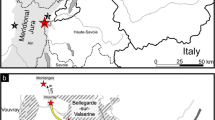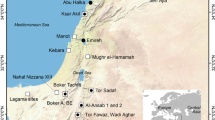Abstract
Hinterland intermountain basins and northern and southern piedmonts of the Qinling Mountains accumulated a large amount of loess during the Pleistocene. The loess strata not only record local paleogeographic and paleoenvironmental changes, but also contain rich hominin fossils and Paleolithic remains. In the northern piedmont of the Qinling Mountains and the lower valley of the South Luohe River, the loess strata have multi loess-paleosol sequences with aeolian loess continuously accumulating during glacial and interglacial cycles. In contrast to the northern piedmont, loess stratigraphy in the hinterland intermountain basins of the Qinling Mountains is relatively thin and contains finer loess particles. In this “mini” type of loess stratum, the density of Paleolithic remain generally is higher than the Loess Plateau in the north of the Qinling Mountains. Based on stratigraphic, chronological, and lithic artifacts analysis in recent years, it appears that the regional lithic assemblage belongs to the Oldowan (Mode I) lithic industry, and it is dominated by choppers, cores, flakes, and simple retouched flake tools from 1.15 to 0.6 Ma. Paleolithic open-air sites such as Gongwangling and Chenjiawo in the Lantian area, Shangbaichuan and Liuwan in the Luonan Basin, Qiaojiayao in the Lushi Basin, Longgangsi and Yaochangwan in the Hanzhong Basin, Guanmiao in the Ankang Basin, and the Yunxian Man Site in the Yunxian Basin are representative sites in the region; from 400 to 250 ka, the Longyadong cave site in the Luonan Basin inherited the characteristics of the local Mode I lithic industry, the stone assemblage is made up of cores, flakes, and small retouched flake tools, such as scrapers, points, and burins; during the period from 250 to 50 ka, bi-facially retouched Acheulean tools (Model II), such as hand-axes, picks, and cleavers, were commonly found in the Qinling Mountains region. The emergence of a large number of Model II artifacts indicates that local lithic industries went through a major transition process. Zhanghuokou, Guoyuan, and Huaishuping sites in the Luonan Basin, Diaozhai, Ganyu, Laochihe, and Xiehu sites in the Lantian area, Hejialiang site in the Hanzhong Basin are representative sites in this period; to the turn of the Late Pleistocene and Early Holocene, it may also exist a small flake-retouched tools lithic industry in the piedmonts of the northern and southern sides of the Qinling Mountains. The lithic assemblages in different stages of the Qinling Mountains region reflect the hominin behavioral changes and the development of lithic technology during the Pleistocene.
Similar content being viewed by others
References
An Z S, Ho C K. 1989. New magnetostratigraphic dates of Lantian Homo erectus (in Chinese). Quat Res, 32: 213–221
Cheng G L, Lin J L, Li S L. 1978. A research on the ages of the strata of Lantian Man (in Chinese). In: IVPP, ed. Collected Papers of Palaeoanthropology. Beijing: Science Press. 151–157
Dai E J. 1966. The Palaeolithic found at Lantian Man locality of Gongwangling and its vicinity (in Chinese). Vert PalAs, 10: 30–32
Dai E J, Ji H X. 1964. Discovery of Palaeolithics at Lantian, Shensi (in Chinese). Vert PalAs, 8: 152–161
Dai E J, Xu C H. 1973. New finds of Palaeolithic from Lantian (in Chinese). Acta Archaeol Sin, 2: 1–12
Du S S, Liu F L, Zhu S W, Zhang M. 2008. Loessic Paleoliths from Lushi county, Henan province (in Chinese). Quat Sci, 28: 1000–1006
Du S S, Liu F L, Zhu S W, Zhang M, Li F, Wang L. 2010. Loessic Paleolithic industry discovered in Luoning county of Henan Province (in Chinese). Archaeol Cult Relics, 2: 14–17
Du S S, Liu F L. 2014. Loessic Paleolith discovery at the Beiyao site, Luoyang, and its implications for understanding the origin of modern humans in Northern China. Quat Int, 349: 308–315
Gai P, You Y Z, 1976. Several characters of the Palaeolithic in Lantian, Shensi (in Chinese). Vert PalAs, 14: 198–203
Huang W W. 1964. On a collection of Paleoliths from Sanmen area in western Honan (in Chinese). Vert PalAs, 8: 162–177
Jia L P, Gai P, Huang W W. 1966. Palaeolithic at Lantian, Shensi (in Chinese). In: IVPP, ed. Cenozoic Group in Lantian District Conference Proceedings. Beijing: Science Press. 151–156
Lei X Y. 1998. Grain-size analysis and genesis of loess in the Qinling Mountains (in Chinese). Acta Geol Sin, 72: 178–188
Lei X Y. 1999. Paleoenvironmental changes recoded by Shangzhou loess- paleosol sequences on the eastern Qinling Mountains during the last 0.6 Ma (in Chinese). Mar Geol Quat Geol, 19: 63–73
Lei X Y. 2000. Vegetation and environment during period of loess-paleosol development in the Qinling Mountains (in Chinese). Mar Geol Quat Geol, 21: 73–79
Liu F L, Du S S. 2010. New discovered loessic Paleolithic sites in Luoyang, Henan (in Chinese). Huaxia Archaeol, 1: 44–48
Liu F L, Du S S. 2011. Research on stone artifacts unearthed in 1998 from the Beiyao loessic Paleolithic site, Luoyang City (in Chinese). Acta Anthropol Sin, 30: 13–21
Liu T S et al. 1985. Loess and the Environment (in Chinese). Beijing: Science Press. 1–381
Liu T S. 1999. Loess stone artifact industry (in Chinese). In: Xu Q Q, ed. New Developments of Prehistoric Archaeology. Beijing: Science Press. 52–62
Liu T S, Ding M L. 1984. A tentative chronological correlation of early human fossil horizons in China with the loess-deep sea records (in Chinese). Acta Anthropol Sin, 3: 93–101
Lu H Y, Zhang H Y, Wang S J, Cosgrove R, Zhao C F, Stevens T, Zhao J. 2007. A preliminary survey on loess deposit in eastern Qinling Mountains (central China) and its implication for estimating age of the Pleistocene lithic artefacts (in Chinese). Quat Sci, 27: 559–567
Lu H Y, Wang X Y, Li L P. 2010. Aeolian sediment evidence that global cooling has driven late Cenozoic stepwise aridification in central Asia. In: Clift P D, Tada R, Zheng H, eds. Monsoon Evolution and Tectonics- Climate Linkage in Asia. Geol Soc Spec Publ, 342: 29–44
Lu H Y, Sun X F, Wang S J, Cosgrove R, Zhang H Y, Yi S W, Ma X L, Wei M, Yang Z Y. 2011a. Ages for hominid occupation in Lushi Basin, middle of South Luohe River, central China. J Hum Evol, 60: 612–617
Lu H Y, Zhang H Y, Wang S J, Cosgrove R, Sun X F, Zhao J, Sun D H, Zhao C F, Shen C, Wei M. 2011b. Multiphase timing of hominin occupations and the paleoenvironment in Luonan Basin, central China. Quat Res, 76: 142–147
Lu H Y, Zhang H Y, Sun X F, Wang S J, Cosgrove R, Shen C, Zhang W C, Zhang X B, Wang X Y, Yi S W, Ma X L, Wei M. 2012. Landforms, loess deposit and paleoenvironmental changes in the South Luohe river (central China) during the hominine occupations (in Chinese). Quat Sci, 32: 167–177
Ma X H, Qian F, Li P, Ju S Q. 1978. The palaeomagnetic dating research of the Homo erectus lantianensis (in Chinese). Vert PalAs, 16: 238–243
Ranov V A. 1989. Does the terms ‘Loessic Paleolithic’ have a right for existence? In: Janshin A L, ed. Quaternary Period: Palaeontology and Archaeology. Kishinnew: Shtiniza. 137–145
Ranov V A. 1995. The ‘loessic Palaeolithic’ in South Tadjikistan, central Asia: Its industries, chronology and correlation. Quat Sci Rev, 14: 731–745
Sun X F, Lu H Y, Wang S J, Yi S W. 2012. Ages of Liangshan Paleolithic sites in Hanzhong basin, central China. Quat Geochron, 10: 380–386
Sun X F, Li Y H, Feng X B, Lu C Q, Lu H Y, Yi S W, Wang S J, Wu S Y. 2015. Pedostratigraphy of eolian deposition near the Yunxian Man site on the Hanjiang River terraces, Yunxian Basin, central China. Quat Int, doi: 10.1016/j.quaint.2015.05.034
Wang S J, Huang P H. 2001. Stratigraphy and TL dating of paleolithic sites in the Luonan Basin, Southern Shaanxi, China (in Chinese). Acta Anthropol Sin, 20: 229–237
Wang S J. 2005. Perspectives on Hominid Behavior and Settlement Patterns: A Study of the Lower Palaeolithic Sites in the Luonan Basin, China. BAR International Series 1406. Oxford: Archaeopress. 1–248
Wang S J. 2007. Huashilang (I)The Palaeolithic Open-air Sites in the Luonan Basin, China (in Chinese). Beijing: Science Press. 1–250
Wang S J, Lu H Y, Zhang H Y, Zhao J, Cosgrove R, Yi S W, Sun X F, Wei M, Garvey J, Ma X L. 2008. A preliminary survey of Paleolithic artifacts and loess deposition in the middle South Luohe River, eastern Qinling Mountains, central China (in Chinese). Quat Sci, 28: 988–999
Wang S J, Liu S M. 2011. New discovered Paleolithic open-air sites in Shangluo City and Shanyang County, Eastern Qinling Mountains, central China (in Chinese). Archaeol Cult Relics, 1: 24–28
Wang S J, Zhang X B, Lu H Y, Xing L D, Zhang G K. 2013. New discovered Palaeolithic open-air sites at Shangdan Basin in the upper Danjiang River valley, eastern Qinling Mountains, central China (in Chinese). Acta Anthropol Sin, 32: 421–431
Wang S J, Lu H Y. 2014. Current perspectives on Paleolithic archaeology in the upper Hanjiang River valley, central China (in Chinese). Acta Anthropol Sin, 33: 315–328
Wang S J, Sun X F, Lu H Y, Yi S W, Zhang G K, Xing L D, Zhuo H X, Yu K F, Wang W. 2014a. Newly discovered Palaeolithic open-air sites in Hanzhong Basin in upper valley of Hanjiang River and their ages (in Chinese). Acta Anthropol Sin, 33: 125–136
Wang S J, Lu H Y, Zhang H Y, Sun X F, Yi S W, Chen Y Y, Zhan G K, Xing L D, Sun W G. 2014b. Newly discovered Paleolithic artifacts from loess deposits and their ages in Lantian, central China. Chin Sci Bull, 59: 651–661
Wang S J, Lu H Y, Xing L D. 2014c. Chronological and typo-technological perspectives on the Paleolithic archaeology in Lantian, central China. Quat Int, 347: 183–192
Wei J W. 1977. Newly discovered Paleolithic in Lantian Man site (in Chinese). Vert PalAs, 15: 223–224
Xia Z K, Zheng G W, Chen F Y, Liu F L, Guo Y Q. 1999. Palaeoliths found in loess strata at Beiyao, Luoyang (in Chinese). Quat Sci, 18: 93
Yang X Y, Xia Z K, Liu T S. Loess research and Paleolithic archaeology in China (in Chinese). Quat Sci, 2005, 25: 461–466
Yang X Y, Liu T S. 2008. Eurasian loess belt and ancient human activities during the early Paleolithic age (in Chinese). Quat Sci, 28: 978–987
Zhang H Y, Lu H Y, Zhao J, Zhao C F, Zhang P. 2008. The effects of ultrasonic dispersion on granulometry results of the fine-grain loess (in Chinese). Acta Sedimentol Sin, 26: 494–500
Zhang H Y, Lu H Y, Jiang S Y, Vandenberghe J, Wang S J, Cosgrove R. 2012. Provenance of loess deposits in the eastern Qinling Mountains (central China) and their implications for the paleoenvironment. Quat Sci Rev, 43: 94–102
Zhang P, Liu W G, Lu H Y, Zhou W J, Zhao C F. 2009. Organic carbon isotope composition of Luonan loess compared with Luochuan and Xifeng loess (in Chinese). Quat Sci, 29: 34–41
Zhao J, Lu H Y, Wang X Y, Zhang H Y, Wang S J. 2008. Magnetic properties of the loess deposit in eastern Qinling Mountains and an investigation on the magnetic susceptibility enhancement (in Chinese). Acta Sedimentol Sin, 26: 1052–1062
Zhu Z Y, Dennell R, Huang W W, Wu Y, Rao Z G, Qiu S F, Xie J B, Liu W, Fu S Q, Han J W, Zhou H Y, Ouyang T P, Li H M. 2014. New dating of the Homo erectus cranium from Lantian (Gongwangling), China. J Hum Evol, 78: 144–157
Author information
Authors and Affiliations
Corresponding authors
Rights and permissions
About this article
Cite this article
Wang, S., Lu, H. Taphonomic and paleoenvironmental issues of the Pleistocene loessic Paleolithic sites in the Qinling Mountains, central China. Sci. China Earth Sci. 59, 1519–1528 (2016). https://doi.org/10.1007/s11430-016-5298-4
Received:
Accepted:
Published:
Issue Date:
DOI: https://doi.org/10.1007/s11430-016-5298-4




